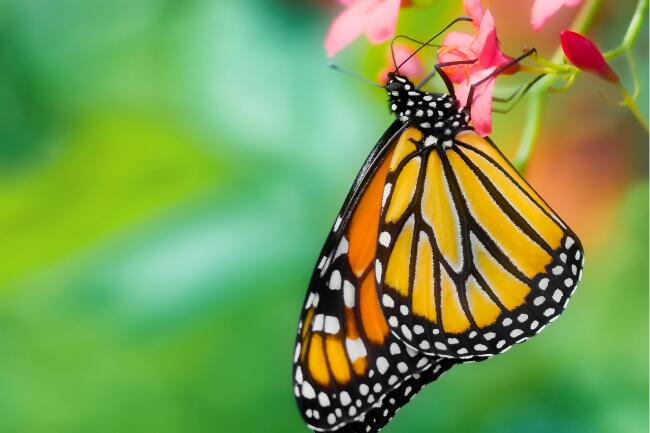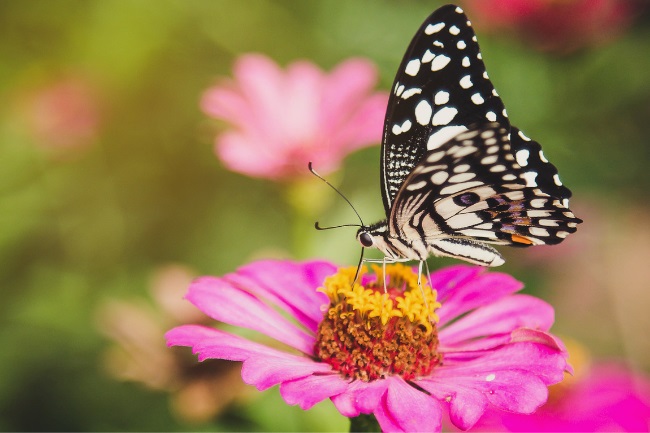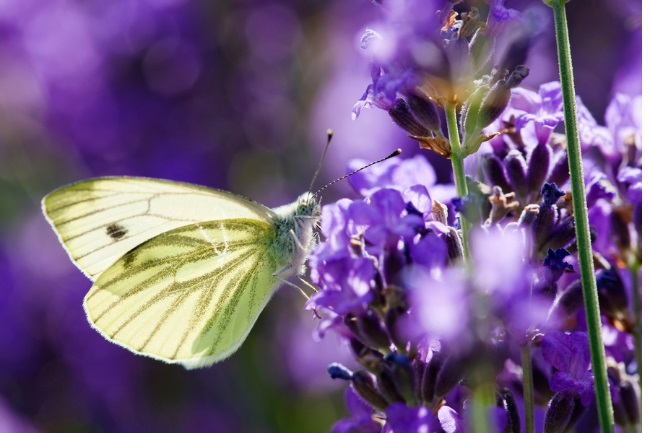The best way to create a butterfly garden is to provide the three things these colourful insects need most; food, shelter and water. From planting butterfly-friendly plants to providing a handy log pile for these sleepy insects to rest in, there’s plenty of ways to make your garden a butterfly’s favourite place to be.
Contents
The beauty of butterflies

Who doesn’t want to walk out into their garden and see a wave of multicolour wings rise from their flowerbeds, lifting up into the sky only to settle afresh on a nearby bloom. Butterflies are perhaps some of our most celebrated and loved insects, so who wouldn’t want to see more of them.
Not only do butterflies come in a wide range and beautiful colours and patterns they are also our garden allies, helping to pollinate our flowers, our fruits and vegetables. So what can we do to create a butterflies paradise, to encourage these creatures into our lives and our gardens?
Plant butterfly-friendly flowers

We may tend to think that all flowers are equally beneficial to insects, but in fact, there are many that have been over-engineered for their beauty over their practicality. For instance, flowers with many different layers of petals can result in few insects being able to get inside to pollinate them.
Flowers with easy access to their nectar are much more pollinator-friendly. Those with tubular or large open flowers, such as lavender, sunflowers and daisies, are often favoured by butterflies. Interestingly different colours can even be attractive to different insects, with butterflies often particularly drawn to white, red, yellow and purple flowers.
Plant native flowers
Gardening, as with many creative pursuits, is often highly influenced by fashion. This means that plants can go in and out of style. When it comes to butterflies, most easily accessible flowers will have some use to them, however, native flowers can be particularly beneficial.
| Plant Name | Common Name | Blooming Season | Preferred Habitat |
|---|---|---|---|
| Asclepias incarnata | Swamp Milkweed | Summer | Moist areas, wetlands |
| Echinacea purpurea | Purple Coneflower | Summer | Open meadows, prairies |
| Buddleja davidii | Butterfly Bush | Summer to Fall | Sunny locations |
| Lantana camara | Lantana | Spring to Fall | Full sun |
| Verbena bonariensis | Verbena | Summer to Fall | Open fields, gardens |
| Salvia spp. | Sage | Summer to Fall | Well-drained soil |
| Zinnia elegans | Zinnia | Summer to Fall | Full sun |
| Coreopsis spp. | Tickseed | Summer | Dry to medium soil |
This is because native plants are more likely to have butterflies that are adapted to feed on them. While this may feel a little restrictive when plants from all across the globe are readily available, native plants needn’t be the only plants in your garden, but can fit in between other garden varieties.
Also read: Why are Bees Important to Plants? (Pollinators)
Provide a fruit buffet

Some butterfly species not only feed on nectar from flowers but will happily suck up the sweet juices from an orange or even a brown banana. Fruit cages or tables can be a great way to leave out old or unwanted fruit for the butterflies. It’s worth remembering though that butterflies don’t have teeth so you will have to break the flesh for them.
Also read: What do Butterflies Eat and Drink? (Detailed Guide)
A place to snooze
Butterflies may require a good dose of sugar water to keep them on their feet, but they also need a nice snug place to rest once all that fluttering is done. At the end of the day, butterflies need somewhere safe to hide away the night before emerging into the sunlight the following day.
Depending on the species they might choose very different sleeping spots, from tucked away in bushes or trees, in woodpiles or even simply clinging to the side of a piece of grass.
While you can’t predict the kind of sleeping quarters your beautiful friend might require, you can provide a wide range of options by planting bushes and trees, creating piles of dead wood and even leaving areas of your lawn long.
The good news is that all this effort won’t go to waste in the winter either as it’s just these kinds of spots that those butterfly species that live for more than a year require to get through the chilly periods.
| Item | Description |
|---|---|
| Butterfly Feeder | A small dish filled with a sugar-water solution or overripe fruit to attract butterflies. |
| Butterfly Puddling Area | A shallow dish filled with sand, mud, or damp soil for butterflies to gather and extract minerals. |
| Butterfly Houses | Small structures with narrow slots or openings for butterflies to roost or hibernate during cold weather. |
| Decorative Stones | Flat stones placed in sunny spots for butterflies to bask and warm their wings. |
| Water Source | A shallow dish or birdbath with fresh water for butterflies to drink from. |
Don’t forget the kids!
It’s easy to despise the caterpillar that’s munching on your cabbage, and love the butterfly that’s visiting your flowers, but it’s important to remember that one comes from the other. If we have no caterpillars in the spring we will have no butterflies in the summer.
So though you may have to put up with a few messy chomp marks it’s worth tolerating these many-legged little creatures. Just as with adult butterflies, native plants will be great for the little caterpillars. They are in fact much fussier than their elders, with many eating only a few types of plants.
| Plant Name | Common Name | Preferred Butterfly Species |
|---|---|---|
| Asclepias spp. | Milkweed | Monarch Butterfly |
| Passiflora spp. | Passionflower | Gulf Fritillary Butterfly |
| Brassica spp. | Mustard Greens | Cabbage White Butterfly |
| Aristolochia spp. | Pipevine | Pipevine Swallowtail |
| Prunus spp. | Cherry, Plum | Eastern Tiger Swallowtail |
| Foeniculum vulgare | Fennel | Black Swallowtail |
| Malus spp. | Apple, Crabapple | Eastern Tiger Swallowtail |
If you do have a flower you want to protect you can outsmart your guests by planting sacrificial plants nearby, which the caterpillars can enjoy while your main crop is ignored.
Also read: What Eats Caterpillars? (A List of its Enemies)
Provide a little water

In general, insects don’t ‘drink’ a great deal. Both caterpillars and butterflies tend to get all the water their need from their food. However, providing a shallow area of water, such as a bowl with large pebbles placed in it, or muddy puddles, can be beneficial when the weather is very hot.
Plant for every season
While summer may be the time we think of butterflies, many are on the wing all year round. In the winter this may only be on unusually warm days, but still, you will often find yourself puzzled at the appearance of a butterfly in the middle of winter.
It is therefore important that you provide food for every month of the year, by choosing plants that will flower in different months throughout the seasons. Of course, there will always be less in flower in early spring and winter, but it’s amazing what a valuable source even these few blooms can be for a hungry butterfly.
Also read: Here’s How and What a Butterfly Eat in The Winter
Give a butterfly a home
Many butterflies have suffered from the various changes we have made to the landscape over the years, but the good news is there are plenty of positive things we can do for them too. Whether you have a balcony or a large garden, every little will help to get our butterflies back on their feet.

